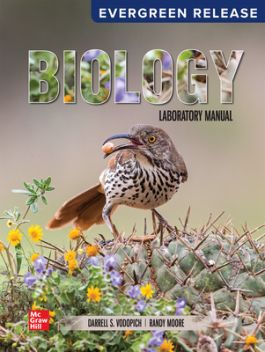Biology Laboratory Manual: 2025 Release
Receive via shipping:
Colour, print bound version of the complete text
1. Scientific Method: The Process of Science
2. Measurements in Biology: The Metric System and Data Analysis
3. The Microscope: Basic Skills of Light Microscopy
4. The Cell: Structure and Function
5. Solutions, Acids, and Bases: The pH Scale
6. Biologically Important Molecules: Carbohydrates, Proteins, Lipids, and Nucleic Acids
7. Separating Organic Compounds: Column Chromatography, Paper Chromatography, and Gel Electrophoresis
8. Spectrophotometry: Identifying Solutes and Determining Their Concentration
9. Diffusion and Osmosis: Passive Movement of Molecules in Biological Systems
10. Cellular Membranes: Effects of Physical and Chemical Stress
11. Enzymes: Factors Affecting the Rate of Activity
12. Respiration: Aerobic and Anaerobic Oxidation of Organic Molecules
13. Photosynthesis: Pigment Separation, Starch Production, and CO2 Uptake
14. Mitosis: Replication of Eukaryotic Cells
15. Meiosis: Reduction Division and Gametogenesis
16. Molecular Biology and Biotechnology: DNA Isolation and Genetic Transformation
17. Genetics: The Principles of Mendel
18. Evolution: Natural Selection and Morphological Change in Green Algae
19. Human Evolution: Skull Examination
20. Ecology: Diversity and Interaction in Plant Communities
21. Community Succession
22. Population Growth: Limitations of the Environment
23. Pollution: The Effects of Chemical, Thermal, and Acidic Pollution
24. Survey of Prokaryotes: Domains Archaea and Bacteria
25. Survey of Protists: Algal Autotrophs
26. Survey of Protists: Protozoan Heterotrophs
27. Survey of the Kingdom Fungi: Molds, Sac Fungi, Mushrooms, and Lichens
28. Survey of the Plant Kingdom: Liverworts, Mosses, and Hornworts of Phyla Hepatophyta, Bryophyta, and Anthocerophyta
29. Survey of the Plant Kingdom: Seedless Vascular Plants of Phyla Pterophyta and Lycophyta
30. Survey of the Plant Kingdom: Gymnosperms of Phyla Cycadophyta, Ginkgophyta, Coniferophyta, and Gnetophyta
31. Survey of the Plant Kingdom: Angiosperms
32. Plant Anatomy: Vegetative Structure of Vascular Plants
33. Plant Physiology: Transpiration
34. Plant Physiology: Tropisms, Nutrition, and Growth Regulators
35. Bioassay: Measuring Physiologically Active Substances
36. Survey of the Animal Kingdom: Phyla Porifera and Cnidaria
37. Survey of the Animal Kingdom: Phyla Platyhelminthes and Mollusca
38. Survey of the Animal Kingdom: Phyla Annelida and Nematoda
39. Survey of the Animal Kingdom: Phylum Arthropoda
40. Survey of the Animal Kingdom: Phyla Echinodermata and Chordata
41. Vertebrate Animal Tissues: Epithelial, Connective, Muscular, and Nervous Tissues
42. Human Biology: The Human Skeletal System
43. Human Biology: Muscles and Muscle Contraction
44. Human Biology: Breathing
45. Human Biology: Circulation and Blood Pressure
46. Human Biology: Sensory Perception
47. Vertebrate Anatomy: External Features and Skeletal System of the Rat
48. Vertebrate Anatomy: Muscles and Internal Organs of the Rat
49. Vertebrate Anatomy: Urogenital and Circulatory Systems of the Rat
50. Embryology: Comparative Morphologies and Strategies of Development
51. Animal Behavior: Taxis, Kinesis, and Agonistic Behavior
Appendix I- Dissection of a Fetal Pig
Appendix II- Conversion of Metric Units to English Units
The Biology Laboratory Manual by Vodopich and Moore was designed for an introductory biology course with a broad survey of basic laboratory techniques. The experiments and procedures are simple, safe, easy to perform, and especially appropriate for large classes. Few experiments require more than one class meeting to complete the procedure. Each exercise includes many photographs, traditional topics, and experiments that help students learn about life. Procedures within each exercise are numerous and discrete so that an exercise can be tailored to the needs of the students, the style of the instructor, and the facilities available.

